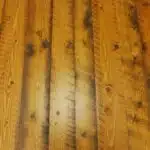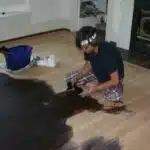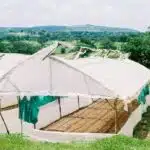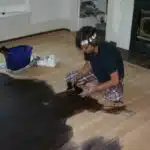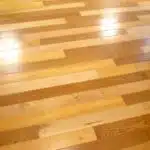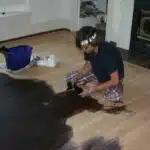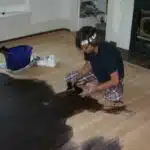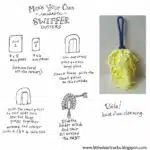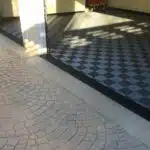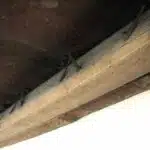Bamboo flooring has become increasingly popular in recent years due to its eco-friendliness, durability, and aesthetic appeal. However, like any other type of flooring, it requires regular maintenance and cleaning in order to maintain its appearance and longevity. As a bamboo floor cleaning expert, I have developed a comprehensive guide on how to properly clean and care for your bamboo flooring.
In this article, you will learn about the best cleaning methods for different types of bamboo flooring, including engineered bamboo and strand-woven bamboo. Additionally, I will provide tips on how to prevent scratches and damage to your flooring during the cleaning process. By following these guidelines, you can ensure that your bamboo flooring remains beautiful and functional for years to come while also serving others by maintaining a clean and healthy environment in your home or business.
Understanding The Basics Of Bamboo Flooring
Bamboo flooring has become increasingly popular in recent years due to its eco-friendliness and durability. It is made from bamboo grass, which is a renewable resource that grows much faster than traditional hardwoods. However, proper cleaning and maintenance are essential to ensure longevity.
Before delving into the cleaning process, it is important to understand the basics of bamboo flooring installation. Bamboo flooring can be installed using either the floating or glue-down method. The floating method involves laying the boards on top of a foam underlayment without any adhesive. On the other hand, the glue-down method requires gluing the boards directly onto a concrete subfloor or an existing wood floor.
Bamboo flooring is known for its durability and strength, making it an excellent option for high-traffic areas such as living rooms and kitchens. However, it is still susceptible to scratches and dents like any other type of wood flooring. It is important to take preventative measures such as placing rugs or mats in high traffic areas and avoiding sharp objects on the surface of the floor to maintain its pristine condition for many years to come.
Moving forward, let’s explore different types of bamboo flooring available in today’s market and how each type differs in terms of durability and maintenance requirements.
Types Of Bamboo Flooring
Strand-woven bamboo flooring is made from shredded bamboo that is compressed together in a resin. Engineered bamboo flooring has a veneer of real bamboo on top of a substrate of plywood. Horizontal and vertical bamboo flooring is different in the direction of the grain. Carbonized and uncarbonized bamboo flooring are distinguished by their color, carbonized bamboo being darker in shade than uncarbonized.
Strand-Woven
Imagine walking on a beautiful bamboo floor that has been maintained and preserved with utmost care. The sight of the glossy surface and smooth texture is bound to leave an impression on anyone who sets foot on it. Among the several types of bamboo flooring, strand-woven flooring stands out for its durability and strength. As a cleaning expert, I am here to guide you through the maintenance process of strand-woven bamboo flooring.
Strand-woven bamboo flooring is made by weaving together thin strands of bamboo under high pressure, resulting in a dense and sturdy material that can withstand heavy foot traffic. However, like any other type of flooring, it requires regular cleaning to maintain its shine and longevity. To clean strand-woven bamboo flooring, start by sweeping or vacuuming the surface to remove dust and dirt particles. Use a damp mop with a mild cleaning solution specifically designed for bamboo floors.
To ensure maximum durability and longevity of your strand-woven bamboo flooring, it is essential to take some preventive measures as well. Avoid using abrasive materials or harsh chemicals that can damage the surface. Place doormats at entrances to prevent dirt from entering the house and scratching the floor’s surface. Use furniture pads underneath all furniture legs to prevent scratches when moving them around.
In conclusion, maintaining strand-woven bamboo flooring is easy if done regularly with proper care and attention. Simple steps such as sweeping regularly, using a mild cleaning solution, avoiding harsh chemicals, placing doormats at entrances, and using furniture pads can go a long way in preserving your floor’s beauty for years to come.
Engineered
Now that we have discussed the maintenance of strand-woven bamboo flooring, let’s move on to another type of bamboo flooring – engineered bamboo flooring. Engineered bamboo flooring is made by layering thin strips of bamboo on top of each other, then bonding them together with an adhesive. The result is a strong and durable material that can be used in areas with high humidity or moisture levels, such as basements or bathrooms.
When it comes to installation, engineered bamboo flooring can be installed using several methods, including glue-down, nail-down or floating. Glue-down installation involves gluing the planks directly onto the subfloor, while nail-down installation requires nailing the planks to a plywood subfloor. Floating installation involves interlocking the planks without any attachment to the subfloor.
Just like strand-woven bamboo flooring, engineered bamboo flooring also requires regular cleaning and maintenance to preserve its beauty and longevity. To clean engineered bamboo flooring, sweep or vacuum regularly to remove dust and dirt particles. Use a damp mop with a mild cleaning solution specifically designed for bamboo floors. Avoid using harsh chemicals or abrasive materials that can damage the surface of the floor. With proper care and attention, your engineered bamboo flooring will maintain its shine and durability for years to come.
Benefits Of Bamboo Flooring
As a bamboo floor cleaning expert, I strongly recommend using an eco-friendly alternative to chemical cleaners. It is not only safe for your health and the environment, but it also helps maintain the longevity of your bamboo flooring. Unlike hardwood floors that require frequent sanding and refinishing, bamboo floors are known for their durability and longevity.
To keep your bamboo floors looking brand new, it’s important to avoid harsh cleaning methods that can damage the surface. Here are four simple tips to help you clean your bamboo flooring effectively:
- Start by sweeping or vacuuming regularly to remove dirt and debris that can scratch the surface.
- Use a damp mop with a mild soap solution made specifically for bamboo floors.
- Avoid using excessive water or leaving standing water on the floor as it can cause warping and discoloration.
- Wipe up spills immediately with a clean, dry cloth.
By following these simple steps, you can ensure that your beautiful bamboo flooring remains in top condition for many years to come. However, there are also common cleaning mistakes that you should avoid in order to maintain its pristine appearance.
Common Cleaning Mistakes To Avoid
Common cleaning mistakes can be detrimental to the longevity and appearance of your bamboo flooring. First and foremost, avoid using excessive amounts of water when cleaning your floors. Bamboo is susceptible to water damage, so it’s important to use only a damp mop or cloth when cleaning. Additionally, never leave standing water on your bamboo floors as this can cause warping and other irreparable damage.
Another common mistake is neglecting to sweep or vacuum regularly. Dirt, dust, and debris can scratch the surface of your bamboo flooring over time if left unattended. It’s recommended to sweep or vacuum at least once a week, more often in high traffic areas. Be sure to use a soft-bristled broom or vacuum attachment to avoid scratches.
Lastly, avoid using harsh chemicals or abrasive cleaning tools on your bamboo flooring. These can cause damage and discoloration that may not be fixable without professional help. Stick to mild cleaners specifically designed for use on hardwood and bamboo floors, and use soft cloths or mops for application.
Effective cleaning techniques are essential for maintaining the beauty and durability of your bamboo flooring. By avoiding common cleaning mistakes such as excessive water usage, neglecting regular sweeping or vacuuming, and using harsh chemicals or abrasive tools, you’ll be able to keep your floors looking like new for years to come.
Next up: Cleaning supplies you’ll need for proper maintenance of your bamboo flooring.
Cleaning Supplies You’ll Need
Like a painter with a blank canvas, cleaning bamboo flooring is an art form that requires precision and care. To ensure the longevity of your bamboo floors, it’s important to use the correct cleaning supplies. In this section, we’ll explore the cleaning products you’ll need to keep your floors looking their best.
When it comes to cleaning bamboo flooring, avoid harsh chemicals that could damage the natural fibers. Instead, opt for non-toxic alternatives that are gentle on the environment and safe for your family. Eco-friendly options such as vinegar and baking soda can effectively clean your floors without leaving any harmful residue behind.
Another essential tool in keeping your bamboo floors clean is a microfiber mop. Microfiber mops are great for trapping dirt and dust particles without scratching or damaging the surface of your floor. When using a microfiber mop, be sure to use a gentle touch and avoid applying too much pressure on the mop head. By incorporating these non-toxic alternatives and eco-friendly options into your cleaning routine, you can help preserve the beauty of your bamboo flooring while also protecting your health and the environment.
Moving forward, sweeping and vacuuming techniques play an important role in maintaining the cleanliness of your bamboo flooring. Let’s explore some tips and tricks for effectively sweeping and vacuuming your floors without causing any damage or scratches.
Sweeping And Vacuuming Techniques
When it comes to cleaning bamboo flooring, sweeping and vacuuming are the two most effective techniques for preventing damage and maintaining quality. The first step in sweeping or vacuuming your bamboo floor is to ensure that you have the best tools for the job. For sweeping, a soft-bristled broom or dust mop is recommended. For vacuuming, use a hardwood floor attachment or a canister vacuum with a bare floor setting.
When sweeping your bamboo floor, start by removing any loose debris such as dirt, dust, or pet hair. Be sure to sweep in the direction of the grain of the bamboo planks to avoid scratching the surface. If using a dust mop, lightly mist it with water or a gentle cleaner before use. This will help trap dirt and prevent it from flying around as you sweep.
Vacuuming your bamboo floor requires some extra care to prevent damage. Be sure to turn off any beater bars on your vacuum and use only a hardwood floor attachment or bare floor setting. Avoid using upright vacuums with heavy wheels that can scratch the surface of your floors. When vacuuming, move in straight lines along the length of each plank, overlapping each pass slightly for thorough cleaning.
By following these effective techniques for sweeping and vacuuming your bamboo flooring using proper tools, you’ll be able to maintain its quality over time while also preventing any damage from occurring. In the next section, we’ll explore different mopping methods that are suitable for various types of bamboo flooring.
Mopping Methods For Different Types Of Bamboo Flooring
Engineered bamboo flooring should be cleaned with a damp mop. It is important to avoid using too much water when cleaning engineered bamboo floors as it can damage the flooring. Strand-woven bamboo flooring should be mopped using a mild detergent solution. This will help to remove dirt and debris without damaging the floor. Solid bamboo flooring should be mopped using a damp cloth or mop and a mild detergent. The mop should be wrung out well to prevent the floor from becoming saturated with water which can damage the flooring. Additionally, it is important to dry the floor after mopping to avoid water spotting and damage. Finally, it is important to use a soft-bristled brush when cleaning bamboo floors as brooms or hard-bristled brushes can damage the floor.
Cleaning Engineered Bamboo Floors
As an expert in cleaning bamboo flooring, it is important to note that engineered bamboo floors require a slightly different approach than traditional bamboo floors. Eco-friendly cleaning options should always be considered when cleaning any type of bamboo flooring, and this is especially true for engineered bamboo floors. Non-toxic solutions are the best choice for keeping your flooring clean without damaging the finish or harming the environment.
When mopping an engineered bamboo floor, it is essential to use a damp mop rather than a wet one. Excess water can cause damage to the flooring, so it’s important to wring out the mop thoroughly before using it on the floor. Additionally, avoid using harsh chemicals or abrasive cleaners as they can scratch or dull the finish of your engineered bamboo floor. Instead, opt for non-toxic and eco-friendly cleaning solutions that are gentle on both your floor and the environment.
To keep your engineered bamboo floor looking its best, it’s recommended that you clean it regularly with a damp mop and non-toxic cleaning solution. For tougher stains or spills, you can use a slightly more concentrated cleaning solution and gently scrub the affected area with a soft-bristled brush. Overall, taking care of your engineered bamboo floor requires a little bit of effort but is well worth it in terms of longevity and environmental impact.
Mopping Strand-Woven Bamboo Floors
As a bamboo floor cleaning expert, it is essential to understand the different types of bamboo flooring and their specific cleaning needs. When it comes to strand-woven bamboo floors, mopping techniques require special attention. Strand-woven bamboo flooring is known for its durability, but it can be susceptible to damage if not cleaned properly. To maintain the longevity of your strand-woven bamboo floor, it’s important to use dry mopping techniques and avoid using wet mopping solutions.
Dry mopping is the best method for cleaning strand-woven bamboo floors as it helps prevent moisture from seeping into the flooring. Using a dry mop or microfiber cloth will pick up dirt and debris without causing any damage to the floor’s finish. It’s important to note that excessive sweeping can cause scratching on the surface of your strand-woven bamboo floor, so it’s recommended to sweep only when necessary.
In addition to dry mopping, spot-cleaning with a damp cloth is also an effective way to clean up spills or stains on your strand-woven bamboo floor. However, make sure that you wring out the cloth thoroughly before wiping down the affected area. Never use harsh chemicals or abrasive cleaners on your strand-woven bamboo floor as they can cause permanent damage to both the finish and the structure of your flooring. By following these simple tips and incorporating eco-friendly cleaning solutions when needed, you can keep your strand-woven bamboo floor looking beautiful for years to come.
Cleaning Solid Bamboo Floors
When it comes to bamboo flooring, solid bamboo is another popular type that requires a specific cleaning approach. Solid bamboo floors are made from compressed strips of bamboo and have a natural resistance to moisture and stains. However, just like any other flooring material, they require regular maintenance to keep them looking their best. As a bamboo floor cleaning expert, it’s important to understand the polishing techniques and cleaning schedule for solid bamboo floors.
Polishing is an essential part of maintaining the appearance of your solid bamboo floor. It helps restore its natural shine and protects the finish from wear and tear. To polish your solid bamboo floor, use a high-quality wax or polish designed specifically for this type of flooring. Apply the product using a microfiber mop or cloth in the direction of the grain, allowing it to dry completely before walking on it.
In terms of cleaning schedule, it’s recommended to sweep or vacuum your solid bamboo floor at least once a week to remove dirt and debris that can scratch the surface over time. You can also use a damp mop with mild soap and water for deeper cleaning as needed, but avoid using excess water as it can damage the flooring’s structure. By incorporating these polishing techniques and following a regular cleaning schedule, you can maintain the beauty and longevity of your solid bamboo floor for years to come.
Spot Cleaning For Stains And Spills
Imagine you just hosted a dinner party with your friends and family, and one of your guests accidentally spilled red wine on your bamboo flooring. You panic and wonder how to clean the mess without damaging your floor. Fear not, as there are ways to clean up stains and spills on bamboo flooring without compromising its quality.
Removing grease stains from bamboo flooring can be challenging, but it is not impossible. Grease stains are usually caused by cooking oil or any oily substance that has been spilled on the floor surface. To remove these types of stains, use a mixture of hot water and dish soap or vinegar. Apply the solution to the affected area and wait for a few minutes before wiping it off with a damp cloth.
Wine spill cleanup can also be done using simple household items such as baking soda and hydrogen peroxide. Mix equal parts of baking soda and hydrogen peroxide together until they form a paste consistency. Then apply the mixture onto the wine stain using a soft-bristled brush or cloth. Leave it for 5-10 minutes before wiping it off with a damp cloth, then dry the area thoroughly.
| Stain Type | Cleaning Solution | Method | Tools Needed |
|---|---|---|---|
| Grease Stains | Hot Water + Dish Soap/Vinegar | Apply solution to affected area and wipe with damp cloth after waiting for several minutes | Soft Cloth |
| Wine Stains | Baking Soda + Hydrogen Peroxide | Apply paste onto stain using soft-bristled brush/cloth, then wipe off after 5-10 minutes with damp cloth; dry thoroughly afterwards | Soft-bristled Brush/Cloth |
Next up – dealing with pet hair and footprints!
Dealing With Pet Hair And Footprints
After dealing with stains and spills, it’s important to address other common issues that come with having bamboo flooring. One of these is the presence of pet hair and footprints, which can leave unsightly marks on the surface. Luckily, there are a few easy steps you can take to keep your bamboo floors looking clean and pristine.
Firstly, removing odors is an important aspect of maintaining your bamboo flooring. This can be particularly important if you have pets or children in your home, as their activities can often leave lingering smells. To combat this issue, try using natural remedies like vinegar or baking soda. These products are highly effective at absorbing odors and can be easily applied by mixing them with water and wiping down the affected areas.
Another issue that many homeowners face when it comes to bamboo flooring is preventing scratches and damage. While bamboo is a durable material, it’s not completely immune to wear and tear over time. To prevent scratches from occurring, always use felt pads on furniture legs when moving items around on the floor. Additionally, avoid wearing shoes with hard soles while indoors as these can cause dents or scrapes on the surface.
Transition: Now that we’ve covered how to remove odors using natural remedies and prevent scratches and damage from occurring on your bamboo flooring, let’s move onto some additional tips for keeping your floors looking their best.
Preventing Scratches And Damage
- Placing area rugs and mats on the bamboo flooring can help protect the floor from scratches and dirt.
- Furniture protectors are another way to prevent scratches and other damage to the bamboo flooring.
- Utilizing coasters and felt pads on the bottoms of furniture can help to reduce the amount of friction on the floor.
- Regularly vacuuming, dusting, and spot cleaning the bamboo flooring will also help to prevent scratches and damage.
Place Mats And Rugs
As a bamboo floor cleaning expert, I understand the importance of protecting your bamboo flooring from scratches and damage. One of the best ways to prevent scratches and damage is by using place mats and rugs. Not only do they add style to your home décor, but they also provide an additional layer of protection for your bamboo floors.
When it comes to choosing the right size of place mat or rug for your bamboo flooring, it is important to ensure that it covers the entire area where foot traffic occurs. This will not only protect against scratches but will also help to prevent water damage that could occur from spills or pet accidents. Additionally, consider using a non-slip pad underneath the rug or mat to prevent slipping and sliding.
Investing in high-quality place mats and rugs can go a long way in maintaining the beauty and durability of your bamboo flooring. By providing an extra layer of bamboo floor protection, you can enjoy your beautiful floors for years to come without worrying about scratches or damage caused by daily wear and tear.
Use Furniture Protectors
To maintain the beauty and durability of your bamboo flooring, it is essential to take preventive measures against scratches and damage caused by daily wear and tear. Aside from using place mats and rugs, another effective way to prevent scratches is by using furniture protectors. As a bamboo floor cleaning expert, I highly recommend investing in high-quality furniture protectors to safeguard your floors.
Using furniture protectors is an easy and cost-effective way to prevent scratches on your bamboo flooring. These protective pads are typically made of felt or rubber materials that are placed under the legs of your furniture. They serve as a barrier between the hard surface of your furniture and the soft surface of your bamboo floors. By doing so, they help reduce friction and prevent scratches caused by moving chairs, tables, or other household items.
Incorporating furniture protectors into your home maintenance routine can significantly extend the life of your bamboo floors. Not only do they provide an extra layer of protection against scratches, but they also help distribute weight evenly across the surface area of each pad, preventing any one point from causing damage. With proper care and maintenance that includes using furniture protectors, you can enjoy beautiful, scratch-free bamboo flooring for years to come.
Maintaining Shine And Luster
As with any type of flooring, maintaining the shine and luster of bamboo requires regular cleaning and polishing. One effective way to keep your bamboo floors looking their best is by using natural cleaning solutions. These solutions are not only better for the environment but also leave behind fewer residues that can dull the shine of your floors over time.
When it comes to polishing techniques, less is often more. Over-polishing can actually damage your bamboo floors by wearing down the protective finish and making them more susceptible to scratches and other types of damage. Instead, focus on spot-cleaning high-traffic areas as needed and using a damp mop or microfiber cloth to gently clean the entire floor surface.
To enhance the shine and luster of your bamboo floors, consider using a natural oil-based polish once or twice a year. Be sure to choose a polish specifically designed for use on bamboo flooring and follow all manufacturer instructions carefully to avoid damaging your floors. With regular cleaning and proper maintenance, you can help ensure that your bamboo floors continue to look beautiful for years to come.
Transitioning into deep cleaning techniques, it’s important to remember that while regular cleaning will help maintain the appearance of your bamboo floors, eventually they will require a deep cleaning. In the next section, we’ll explore some effective techniques for removing stubborn stains and restoring the original shine and luster of your bamboo flooring.
Deep Cleaning Techniques
As bamboo flooring has grown in popularity, it’s important to understand the proper cleaning techniques. While regular sweeping and mopping can help maintain the floor’s appearance, a deeper clean may be necessary from time to time. One option for deep cleaning is steam cleaning. However, it is important to note that excessive moisture can damage bamboo flooring, so caution should be taken when using this method.
Another eco-friendly option for deep cleaning is vinegar and water solution. Mix equal parts of white vinegar and warm water in a spray bottle and apply to the floor. Be sure to use a damp mop rather than a soaking wet one when cleaning with this solution. Additionally, it’s important to rinse the floor with clean water after cleaning with vinegar to avoid any residue buildup.
Incorporating both steam cleaning and eco-friendly options into your bamboo floor cleaning routine can help ensure that your floors are both clean and well-maintained over time. In the next section, we will explore some DIY cleaning solutions that you can easily make at home for everyday maintenance of your bamboo flooring.
Diy Cleaning Solutions
As a bamboo floor cleaning expert, I understand that sometimes commercial cleaning solutions can be too harsh for your floors. Fortunately, there are homemade solutions that you can make using ingredients found in your kitchen. Not only are these eco-friendly options, but they’re also affordable and easy to make.
One of the most effective natural cleaning agents is vinegar. Mix equal parts of white vinegar and water and use a damp mop to clean your bamboo floors. Vinegar cuts through grease and grime, leaving behind a sparkling clean surface without damaging the finish of your floors. For an added fragrance, you can add a few drops of essential oils like lavender or lemon.
Another homemade solution that works wonders on bamboo floors is baking soda mixed with warm water. This mixture is perfect for removing stubborn stains and dirt buildup from high-traffic areas of your floor. Simply sprinkle baking soda onto the affected area and let it sit for 5-10 minutes before scrubbing with a soft-bristle brush or cloth.
When it comes to taking care of your bamboo floors, there are plenty of eco-friendly options available that won’t harm the environment or your health. Homemade cleaning solutions using vinegar or baking soda are just some examples of how you can maintain the beauty and longevity of your bamboo flooring without breaking the bank. In the next section, we’ll explore another option for keeping your floors looking their best: hiring professional cleaners.
Hiring Professional Cleaners
Now that you know how to clean bamboo flooring on your own, you may be wondering if it’s worth the cost to hire professional cleaners. While DIY cleaning solutions can save you money, there are some benefits to hiring professionals. For one, they have access to commercial-grade equipment and products that can achieve a deeper clean than what is possible with household cleaners. Additionally, they can save you time and energy by doing the job quickly and efficiently.
When considering the cost benefit of professional cleaners, it’s important to assess your individual needs. If you have a busy schedule or simply don’t enjoy cleaning, hiring professionals may be worth the investment. On the other hand, if you have the time and resources to clean your floors yourself, it may not be necessary to hire outside help.
If you do decide to hire professional cleaners, it’s important to research and find reliable cleaning services in your area. Look for companies with positive reviews and a track record of providing high-quality services. Be sure to ask about their experience with bamboo flooring specifically, as this type of flooring requires specialized care. By taking these steps, you can ensure that your floors are in good hands and will be properly maintained for years to come.
As a bamboo floor cleaning expert, I recommend weighing the pros and cons of both DIY cleaning solutions and professional cleaning services before making a decision. While DIY solutions can save money in the short term, investing in professional cleaners could ultimately save time and provide a deeper level of cleanliness for your floors. When looking for reliable cleaning services, take the time to research companies thoroughly so that you can feel confident in your choice. In the next section, we will address some frequently asked questions about bamboo flooring cleaning that may further help guide your decision-making process.
Frequently Asked Questions About Bamboo Flooring Cleaning
When it comes to cleaning bamboo flooring, there are a few techniques that can help ensure your floors remain in great condition. Firstly, make sure you vacuum or sweep the floor regularly to remove any dirt or debris. Using a soft-bristled brush attachment is best as it won’t scratch the surface of the bamboo.
Another important aspect of cleaning bamboo flooring is to avoid using water or steam mops. Bamboo is a natural material that is sensitive to moisture, so excess water can cause damage over time. Instead, use a damp mop with minimal water and dry the floor immediately after mopping.
Choosing the right cleaning products for bamboo floors is also crucial. Avoid harsh chemicals or abrasive cleaners as these can cause damage to the finish of your floors. Instead, opt for gentle cleaners specifically designed for use on bamboo flooring. Regular maintenance and care will keep your bamboo flooring looking beautiful for years to come.
Conclusion
Bamboo flooring has become a popular option for homeowners, and for good reason. Not only is it an eco-friendly alternative to hardwood floors, but it’s also durable and visually appealing. However, like any flooring material, bamboo requires regular cleaning and maintenance to keep it looking its best.
In this article, we have covered the basics of bamboo flooring, including the different types available and the benefits of choosing bamboo over other materials. We have also discussed common cleaning mistakes to avoid and provided a list of cleaning supplies you’ll need. From deep cleaning techniques to DIY cleaning solutions, we’ve got you covered.
As a bamboo floor cleaning expert, I highly recommend taking the time to properly clean and maintain your bamboo floors. Not only will it help prolong their lifespan, but it will also ensure they look beautiful for years to come. Whether you choose to do it yourself or hire a professional cleaner, always remember to avoid harsh chemicals and abrasive tools that can damage the surface of your floors.
In conclusion, keeping your bamboo floors in tip-top shape doesn’t have to be difficult or time-consuming. By following our tips and advice outlined in this article, you can enjoy the many benefits of bamboo while keeping your home clean and beautiful. Don’t hesitate to reach out with any further questions or concerns – happy cleaning!
Image Credits
- “installing the bamboo floor” by fishermansdaughter (featured)


